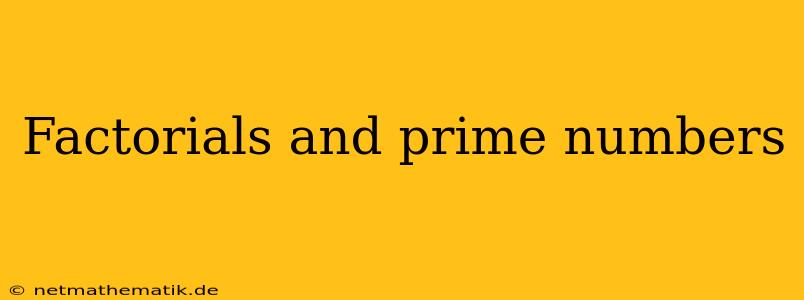The realm of mathematics is filled with intriguing concepts, and among them, factorials and prime numbers stand out as fundamental building blocks. Factorials, denoted by the exclamation mark (!), represent the product of all positive integers less than or equal to a given number. Prime numbers, on the other hand, are whole numbers greater than 1 that are divisible only by 1 and themselves. While seemingly distinct, these two concepts intertwine in fascinating ways, revealing intricate relationships that enrich our understanding of number theory. This article delves into the world of factorials and prime numbers, exploring their individual characteristics, their connection through the prime factorization of factorials, and the role they play in various mathematical applications.
Understanding Factorials
A factorial, denoted as n!, represents the product of all positive integers less than or equal to a given non-negative integer "n". For example, 5! = 5 * 4 * 3 * 2 * 1 = 120. Factorials are used in various areas of mathematics, including probability, combinatorics, and calculus.
Properties of Factorials
- Base Case: 0! is defined as 1.
- Recursive Definition: n! = n * (n-1)! for n > 0.
- Growth Rate: Factorials grow very rapidly. For example, 10! = 3,628,800.
- Divisibility: Factorials are divisible by all positive integers less than or equal to n.
Prime Numbers: The Building Blocks of Integers
A prime number is a whole number greater than 1 that has exactly two distinct positive divisors: 1 and itself. The first few prime numbers are 2, 3, 5, 7, 11, 13, 17, and so on. Prime numbers are considered the building blocks of all integers, as every integer greater than 1 can be uniquely expressed as a product of prime numbers. This is known as the Fundamental Theorem of Arithmetic.
Properties of Prime Numbers
- Infinitude: There are infinitely many prime numbers.
- Distribution: Prime numbers become less frequent as numbers get larger.
- Unique Factorization: Every integer greater than 1 can be uniquely expressed as a product of prime numbers (ignoring the order of the factors).
The Interplay of Factorials and Prime Numbers
The connection between factorials and prime numbers lies in the prime factorization of factorials. When you expand a factorial, you essentially multiply all the positive integers up to that number. This multiplication includes prime numbers, and these prime numbers will appear multiple times within the factorial. For example, the prime factorization of 5! is:
5! = 5 * 4 * 3 * 2 * 1 = 2<sup>3</sup> * 3 * 5
Determining Prime Factors in Factorials
To determine the prime factors of a factorial, we can use the following approach:
- Identify the prime number p: We want to find how many times the prime number 'p' appears in the prime factorization of n!.
- Calculate the highest power of p less than or equal to n: This is done by repeatedly dividing n by p and keeping track of the quotient until the quotient becomes less than p.
- Sum the quotients: The sum of these quotients represents the highest power of p that divides n!.
Example: Let's determine the highest power of 3 that divides 10!
- 10 / 3 = 3 (quotient = 3)
- 3 / 3 = 1 (quotient = 1)
The sum of the quotients is 3 + 1 = 4. Therefore, 3<sup>4</sup> is the highest power of 3 that divides 10!.
Applications and Significance
The relationship between factorials and prime numbers has significant applications in various areas of mathematics and computer science:
- Combinatorics: Factorials are fundamental in combinatorics, particularly in counting permutations and combinations.
- Number Theory: The prime factorization of factorials plays a key role in understanding the distribution of prime numbers and their relationships with other integers.
- Cryptography: Prime numbers are essential in modern cryptography, and the prime factorization of factorials has implications in certain cryptographic algorithms.
- Algorithms: Prime numbers and factorials are involved in several algorithms, including the Sieve of Eratosthenes for finding prime numbers and algorithms for calculating factorials efficiently.
Conclusion
The interplay between factorials and prime numbers showcases the intricate beauty and interconnectedness of mathematical concepts. Understanding the prime factorization of factorials provides insights into the distribution of prime numbers and their influence on the structure of integers. This connection has wide-ranging applications, from counting possibilities in combinatorics to underpinning modern cryptographic systems. As we delve deeper into the study of number theory, the relationship between factorials and prime numbers continues to reveal fascinating insights and inspire further exploration.
